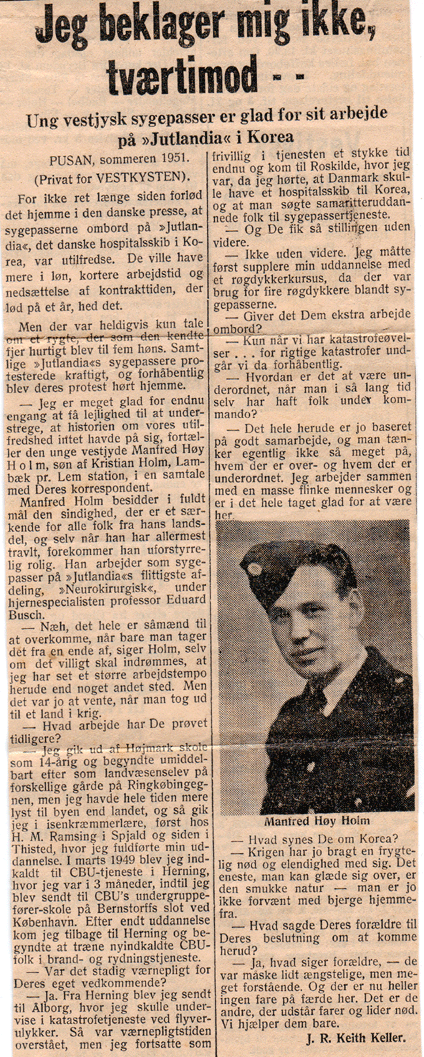JUTLANDIA
The
[This information was supplied to The Korean War Educator by Hoy Helm of
BRIEF HISTORY
The Jutlandia was built as a
combined cargo and passenger ship in Denmark in 1934 for The East Asiatic Company Ltd.
During the second world war, she was "trapped" in Danish waters and had to be laid
up. Fortunately, she was not seized by the German occupation forces, since
they did not have the diesel oil needed to sail it. The vessel was rebuilt
after the war and resumed normal civil service, sailing from
After the North Korean assault on
After some quick investigations, the
Danish committee decided that the M/S Jutlandia was the most suitable ship available in a hurry. The ship owner, the East Asiatic Company, had immediately given its consent to
transfer the ship to U.N. service, but the ship was on its way to New York when this decision was made. There had been no time to inform the master, so he was rather surprised when
arriving to
The ship was rushed home and as soon
as the ship arrived at the shipyard in
On the 23rd of January
1951, they ran up the flags of U.N., Dannebrog (name of the Danish flag in Danish), and the
Red Cross--the three flags the ship was to fly for nearly three years--and left Denmark from the port of Copenhagen
from the most prominent quay, Langelinie, where the Jutlandia Memorial, made in granite from South Korean
mountains and supported by Korea’s veterans, is now placed.
The ship was then probably the most
modern hospital in Denmark and had wards with a total of 356 hospital beds (during normal service), 4 (+1) operating
rooms, X-ray-, eye-, and dental clinics, laboratories, pharmacy and other specialized departments. The hospital had a staff of 91 persons: professors, doctors, specialists,
nurses and assistants. The ships crew amounted to 97 from the captain to
youngest sailor. The head of the "expedition" during all three years was
the Danish Commodore Kai Hammerich.
After arriving in
As the first allied hospital unit
serving in Korea, the hospital staff of Jutlandia demanded permission from the Allied Staff—contrary to the
then normal procedure—to be allowed to handle Korean patients, civil as well as military, whenever it was possible. After some discussions this just claim was granted on the condition that in
case of severe fighting, the soldiers should have first priority and civil patients had to be sent ashore. Fortunately this only happened once, except naturally when the ship had to sail
for
During the service in
Sometime after the ceasefire on
On
LAESERBREVE
A Letter to the Editor ("Bien" newspaper)
About the Jutlandia
Dear Poul Andersen,
Thank you very much for the beautiful picture of
Jutlandia in your September 28th Bien. It brought back many
wonderful memories from my 2 ˝ years on the ship on both the first and the second trip to
We left
I remember the first time we
arrived in
We were surprised because a very
large Army band was waiting for us and started playing the Danish national anthem.
We were very moved that they had taken the time to learn to play our anthem.
After that it sure changed, because they started to play: "If I knew you were coming, I’d have baked a cake,"
etc. After that they entertained us for about one hour, I think. We didn’t know if we should laugh or cry, so we did a little of both.
As shown in your article, the
USS Consolation had a reunion on the Queen Mary and they were trying to invite
people who had been on the Jutlandia. So I faxed a note to Bien and
were then connected with Ted Bobinski, the chairman for the reunion committee. I was not able to contact Ane Marie Gore, who was a nurse on the Jutlandia,
and was already on the Queen Mary. Ted Bobinski was just wonderful
to talk with and even though we had missed the first day of the fun, he wanted me to attend the next two day’s
activities, and Nancy came along. We had a wonderful time and met so many
interesting people, as we were also invited to join him and his wife plus Ane Marie Gore at his table. Thank you very much, Poul Anderson, for making this possible. – Hoy Holm,
NEWSPAPER CLIPPING
(written in the Danish language)
